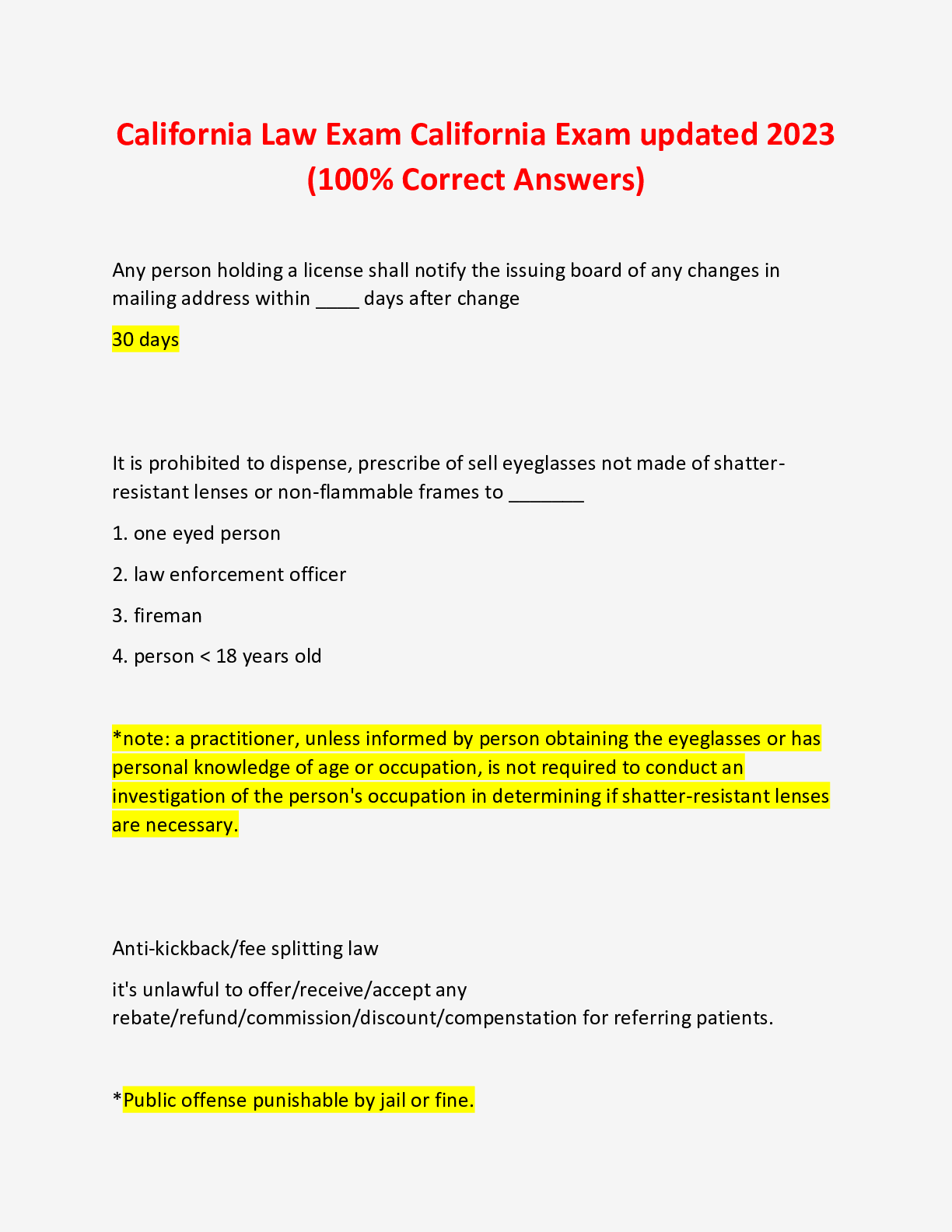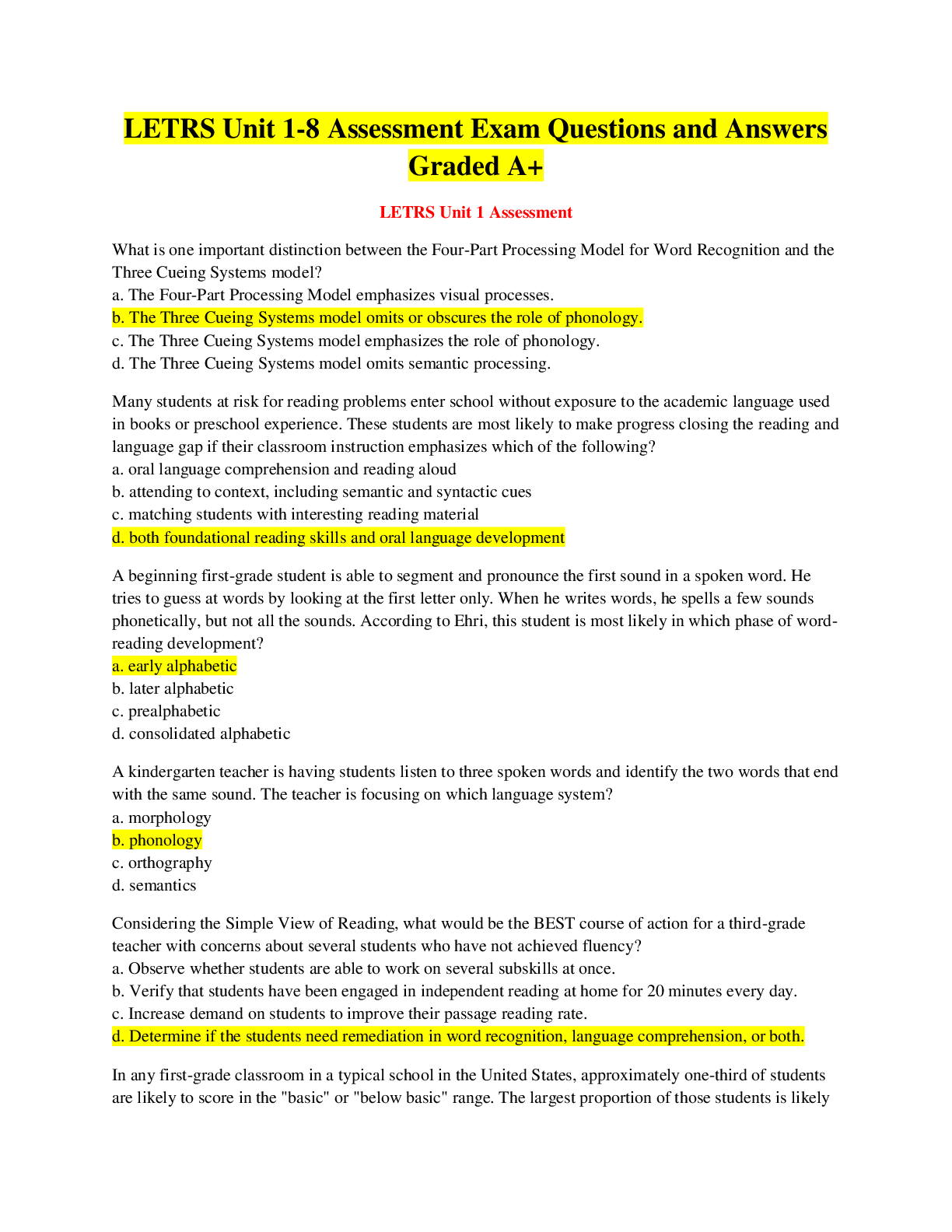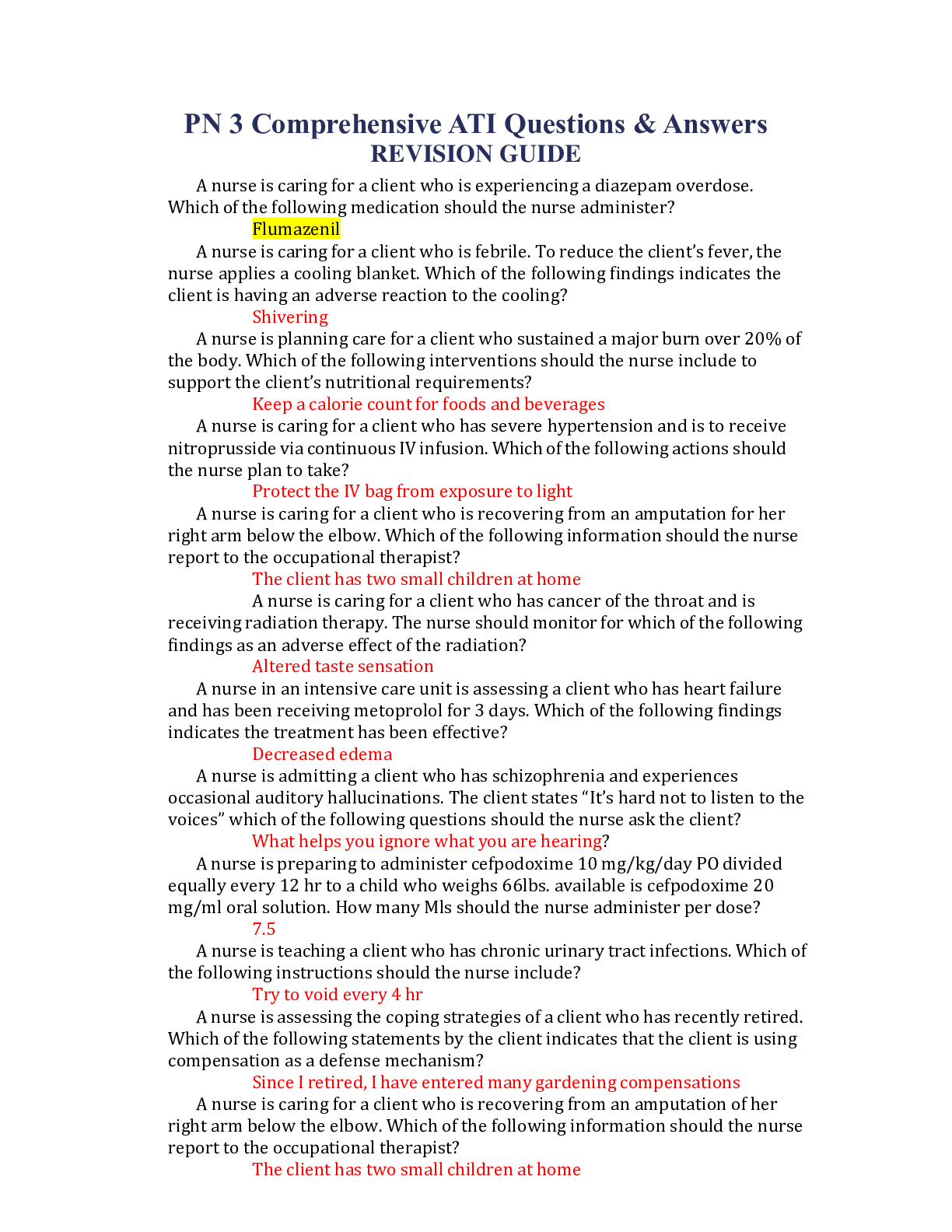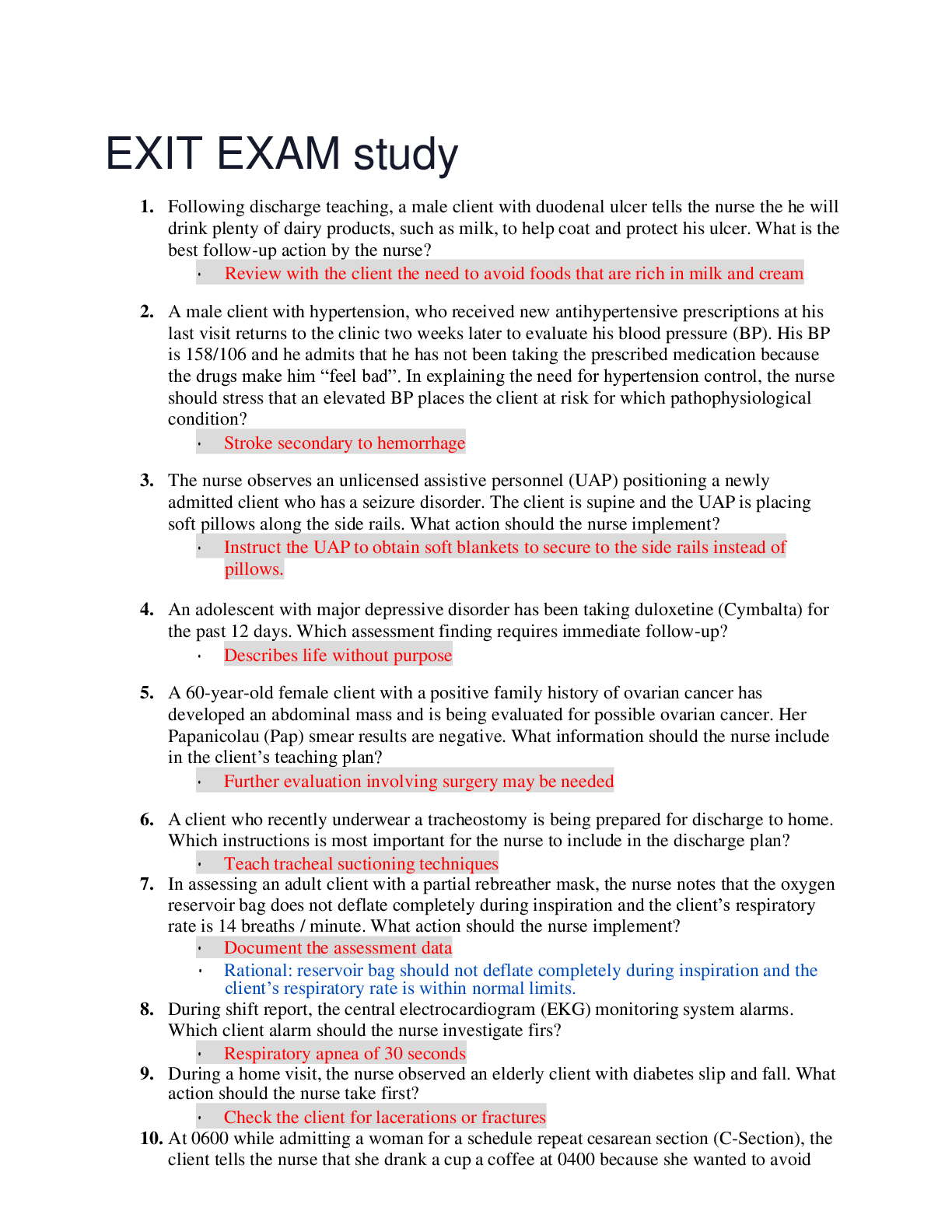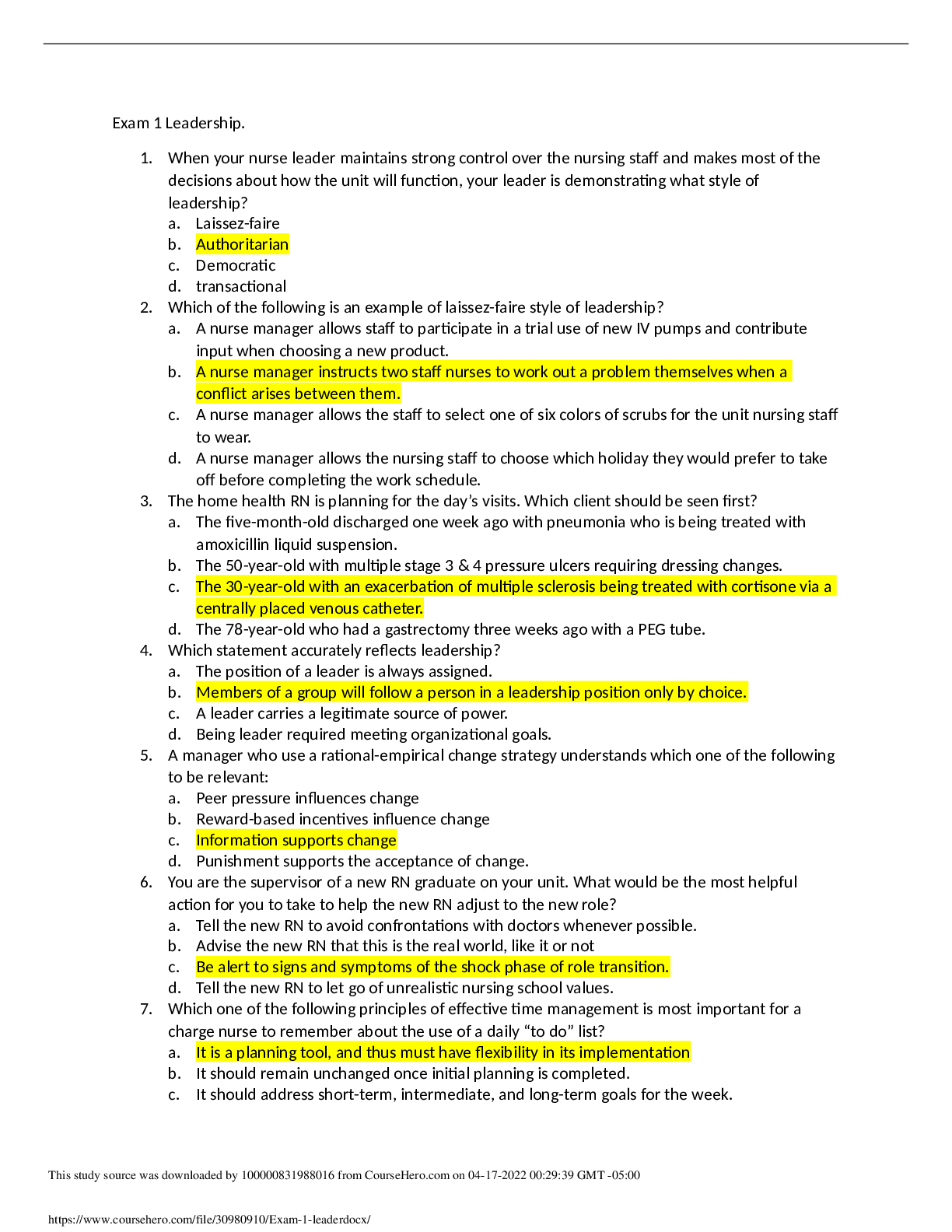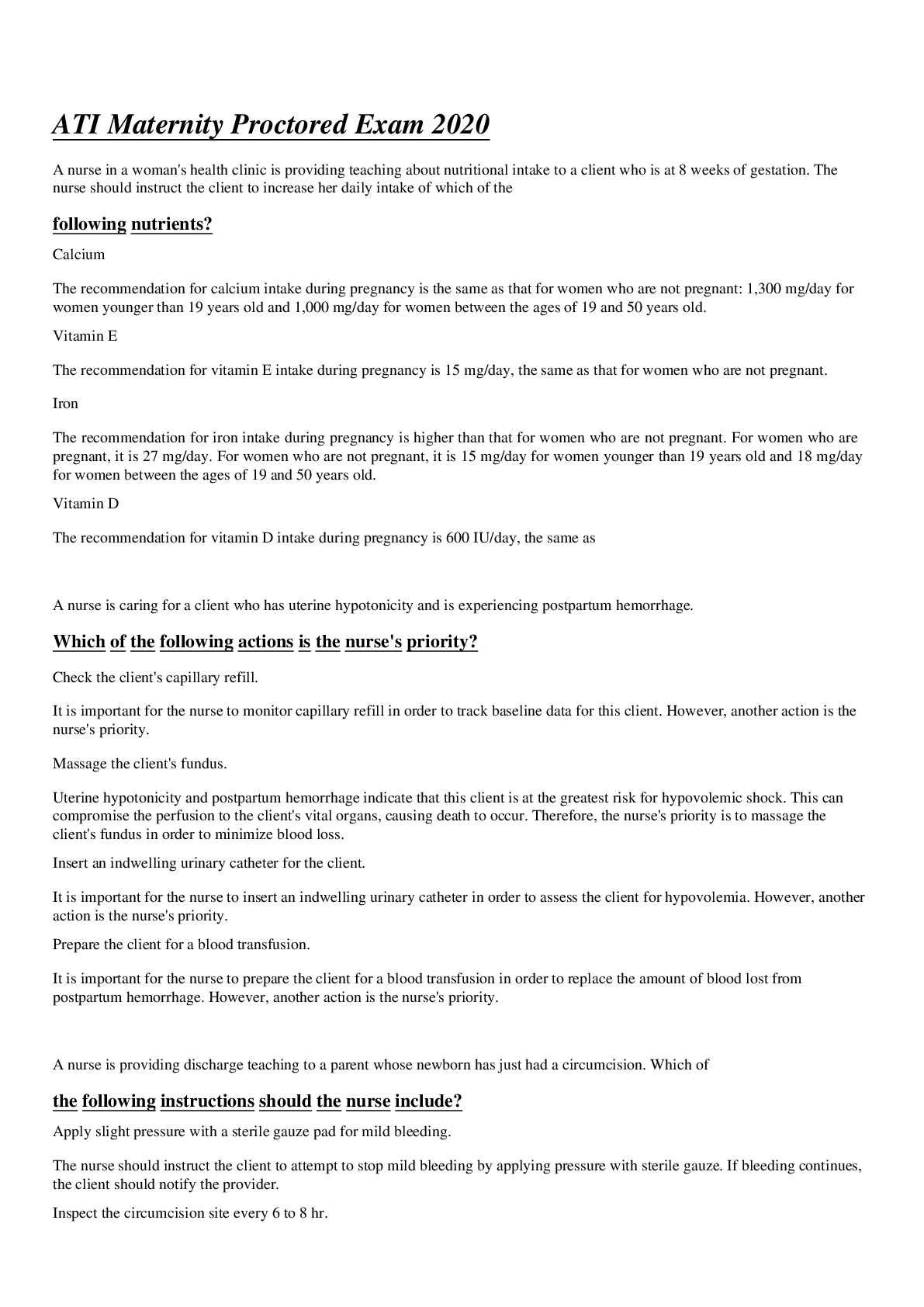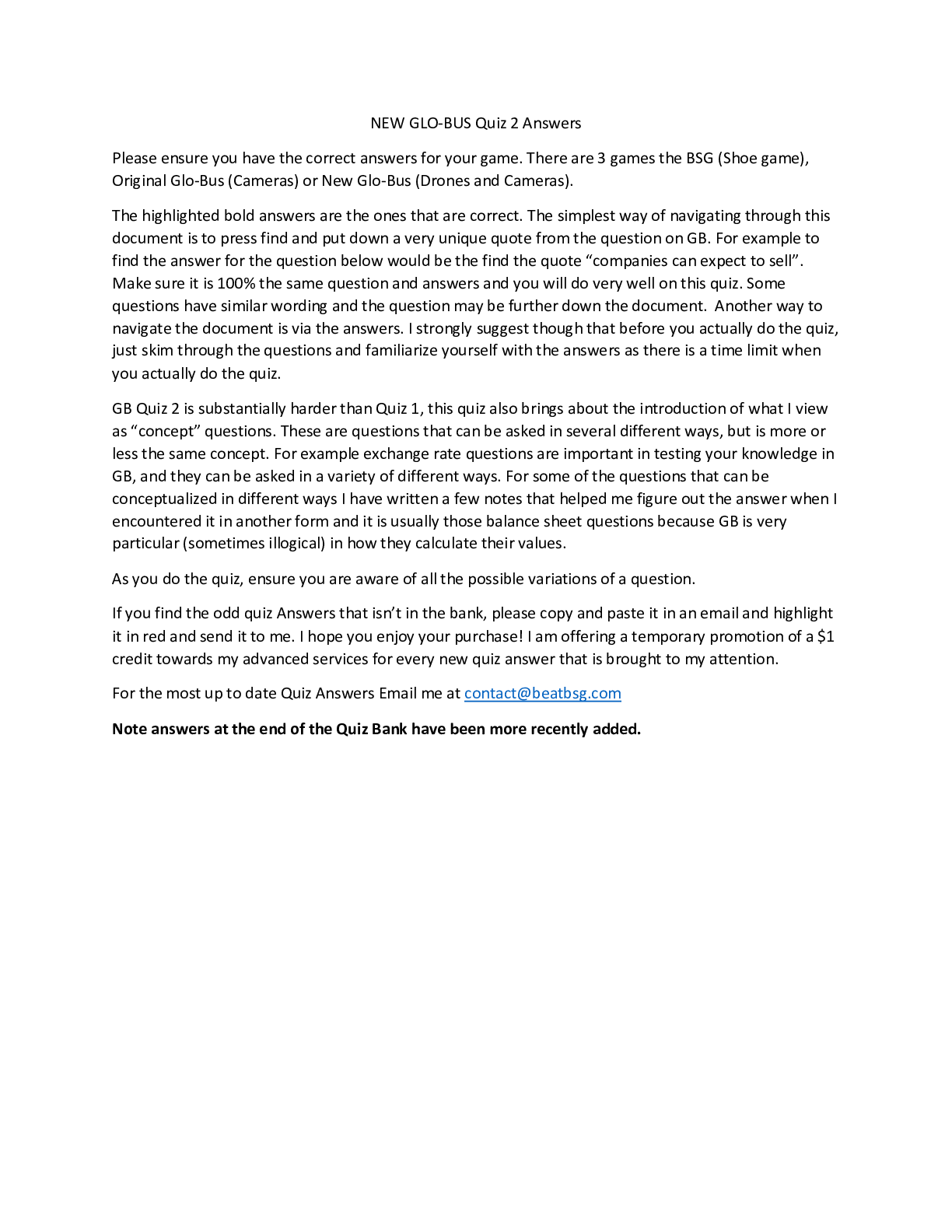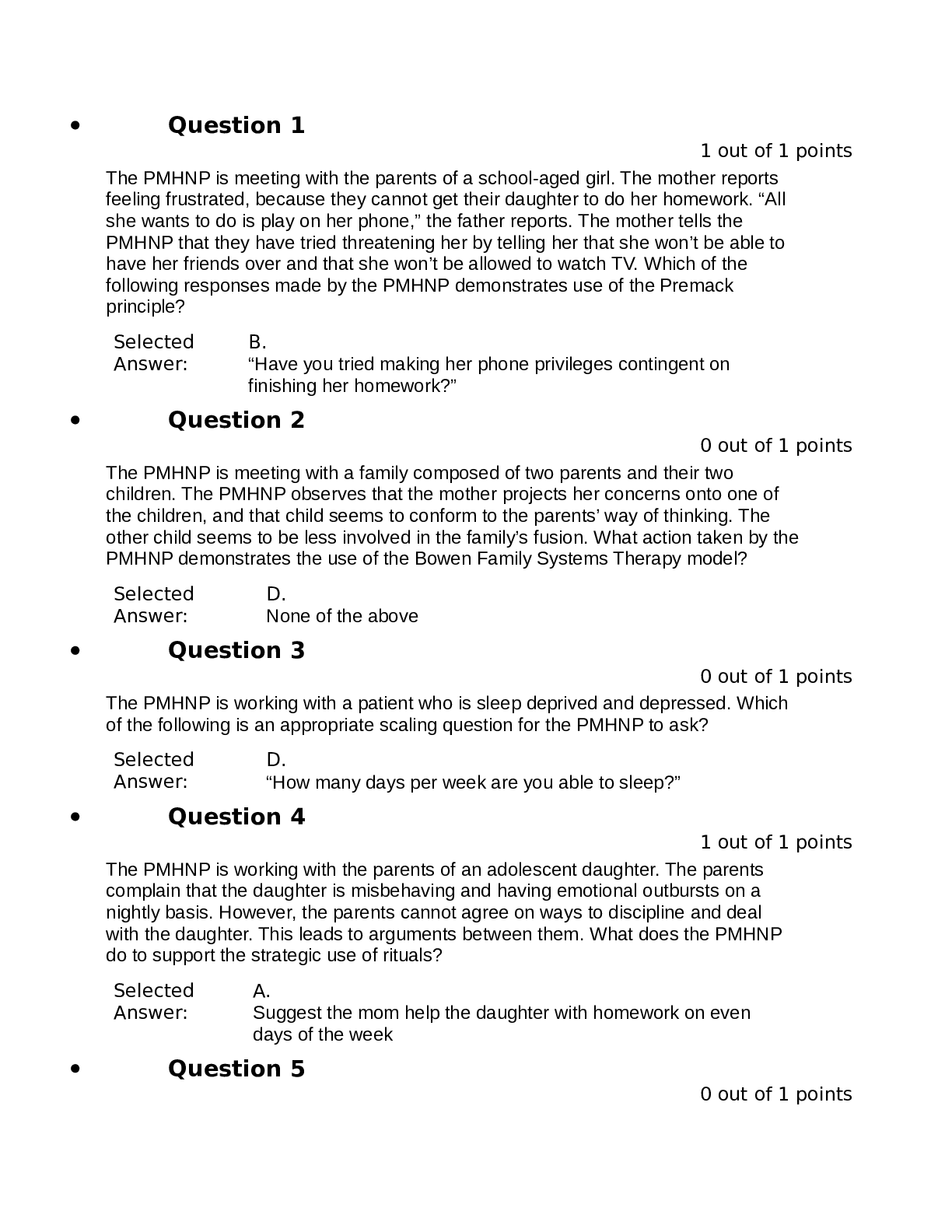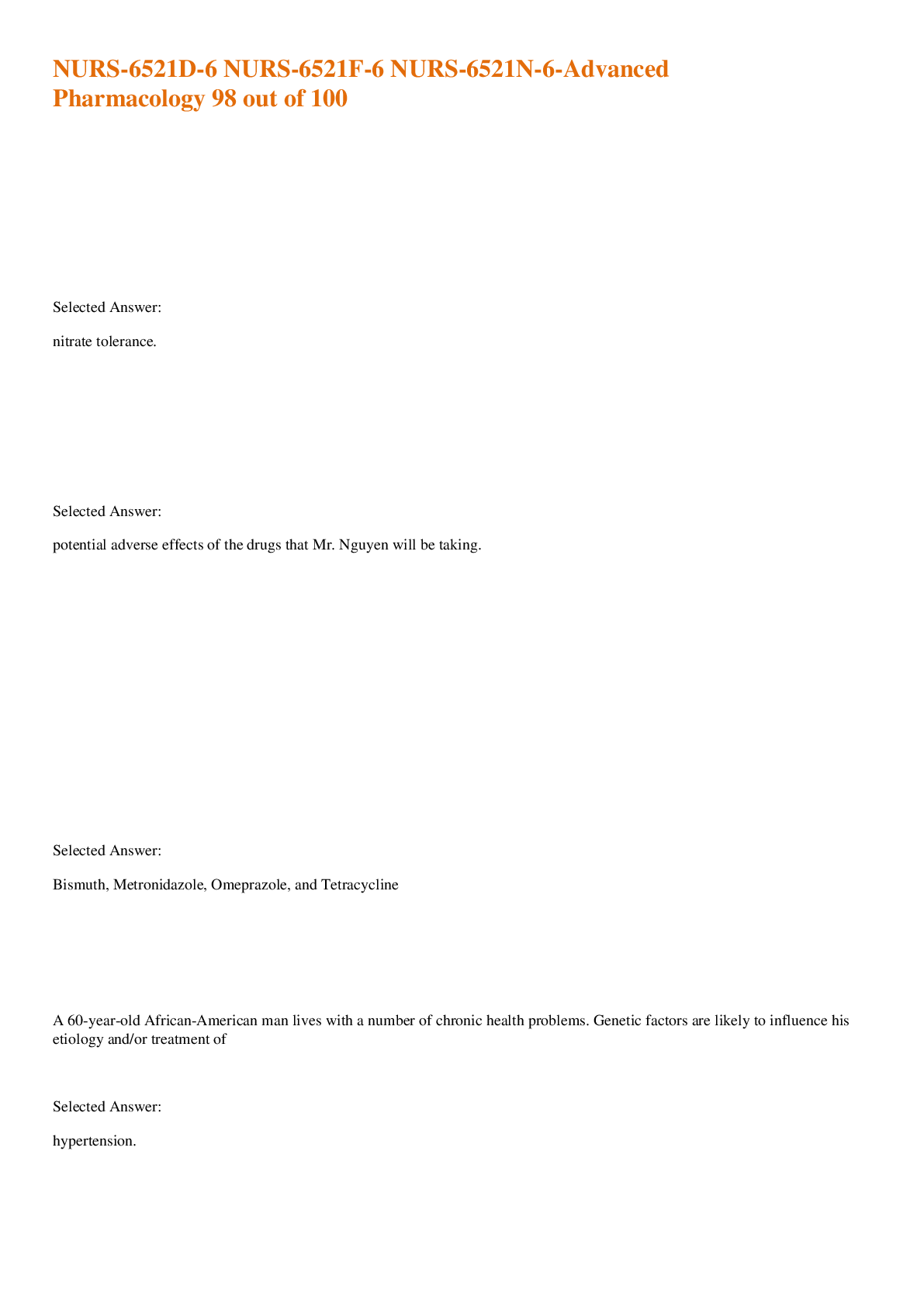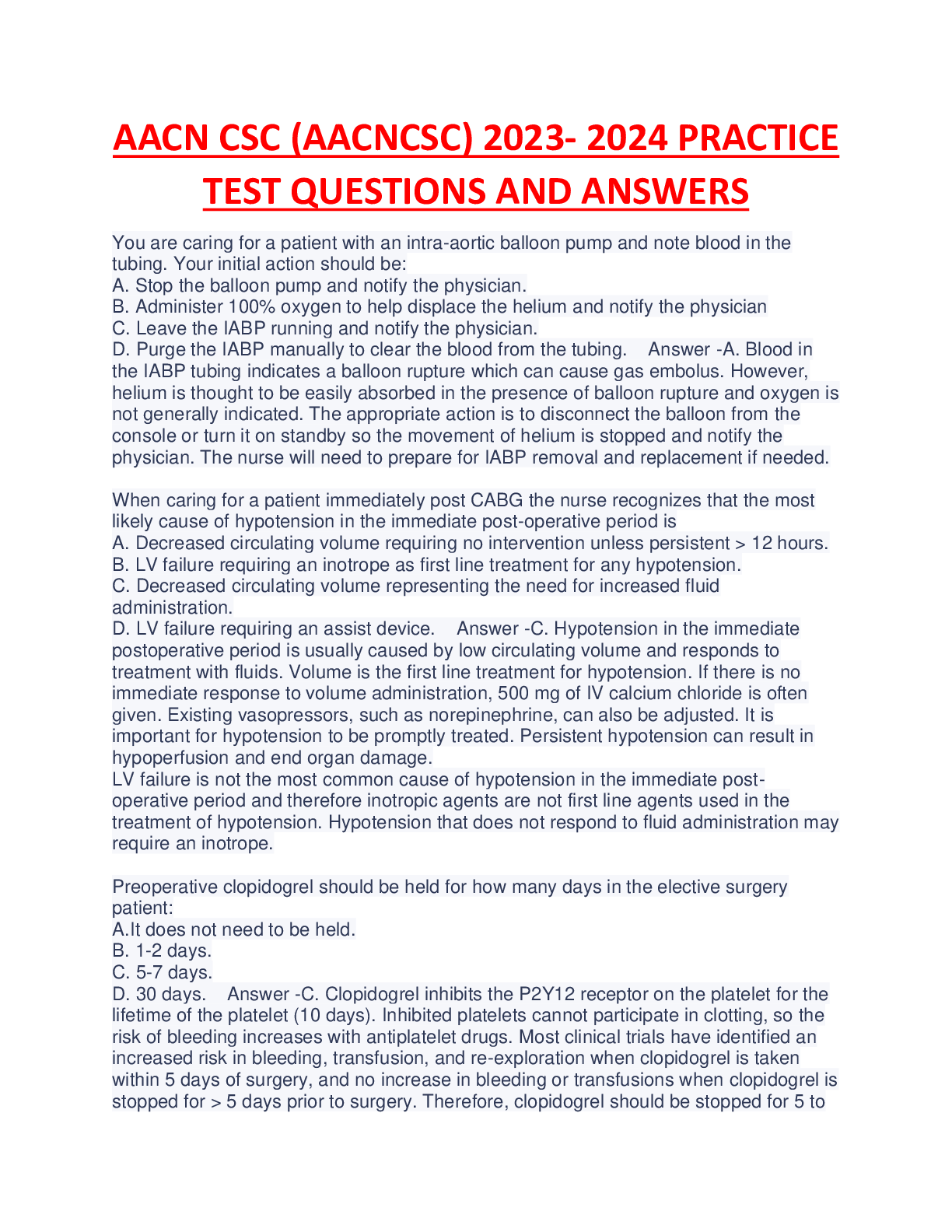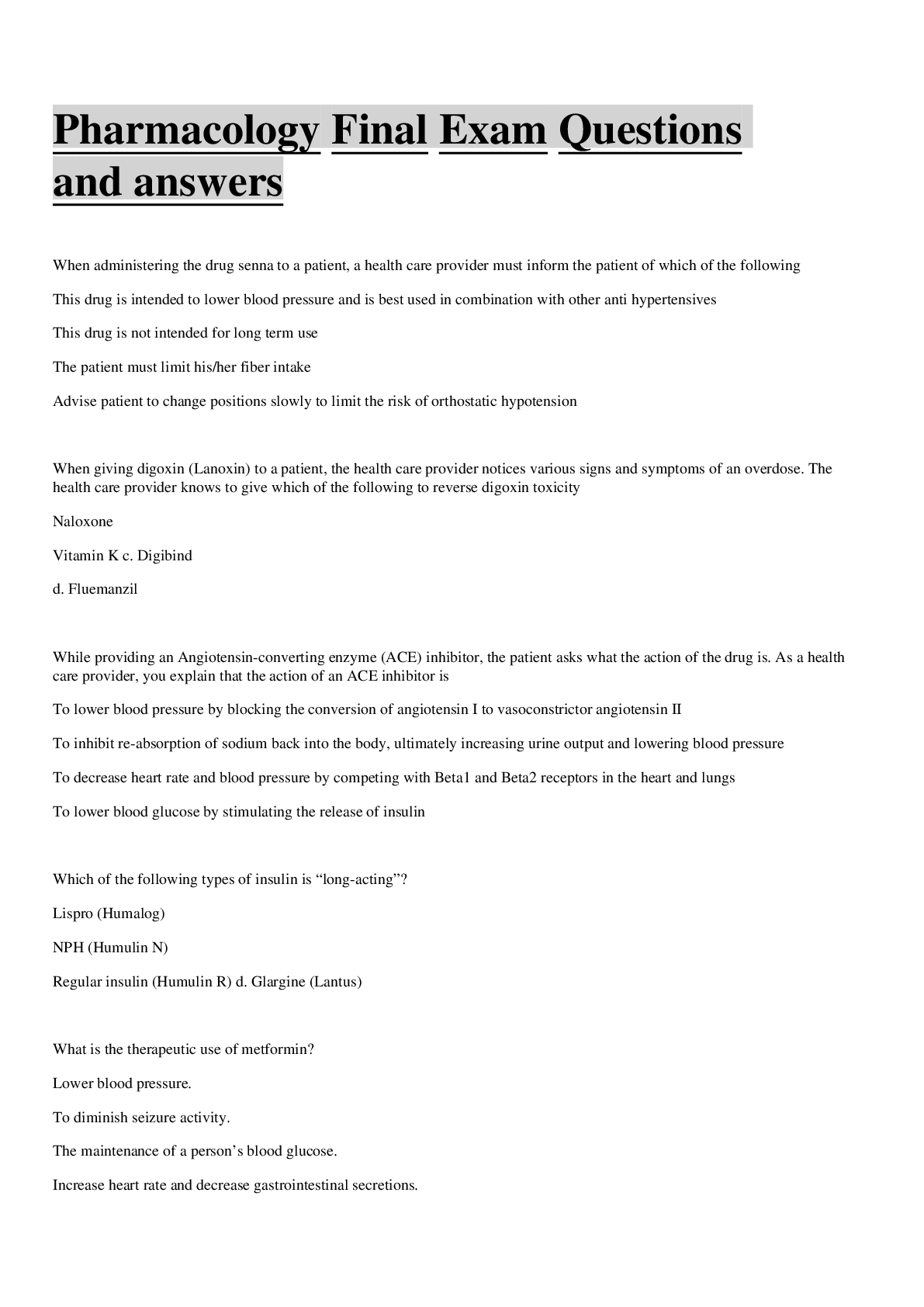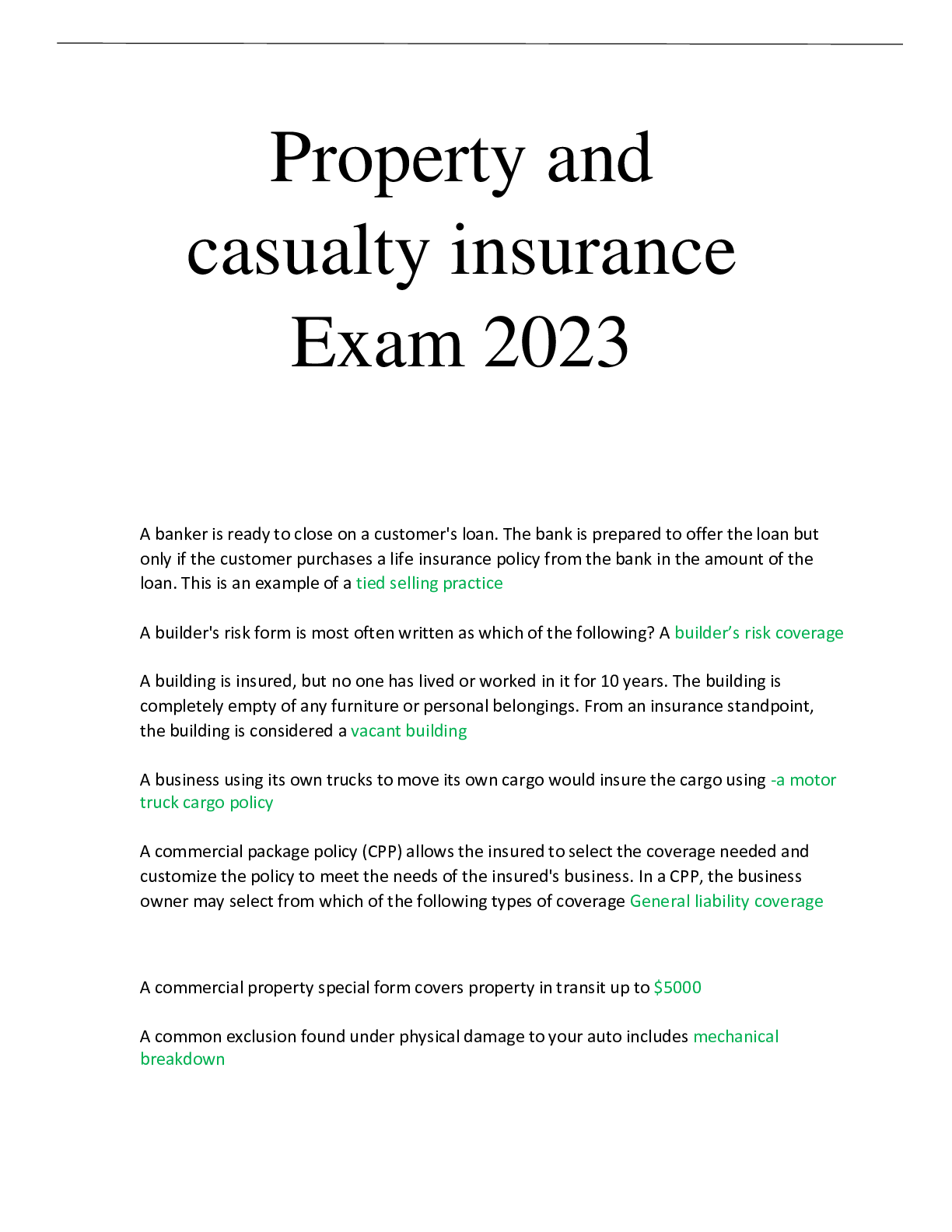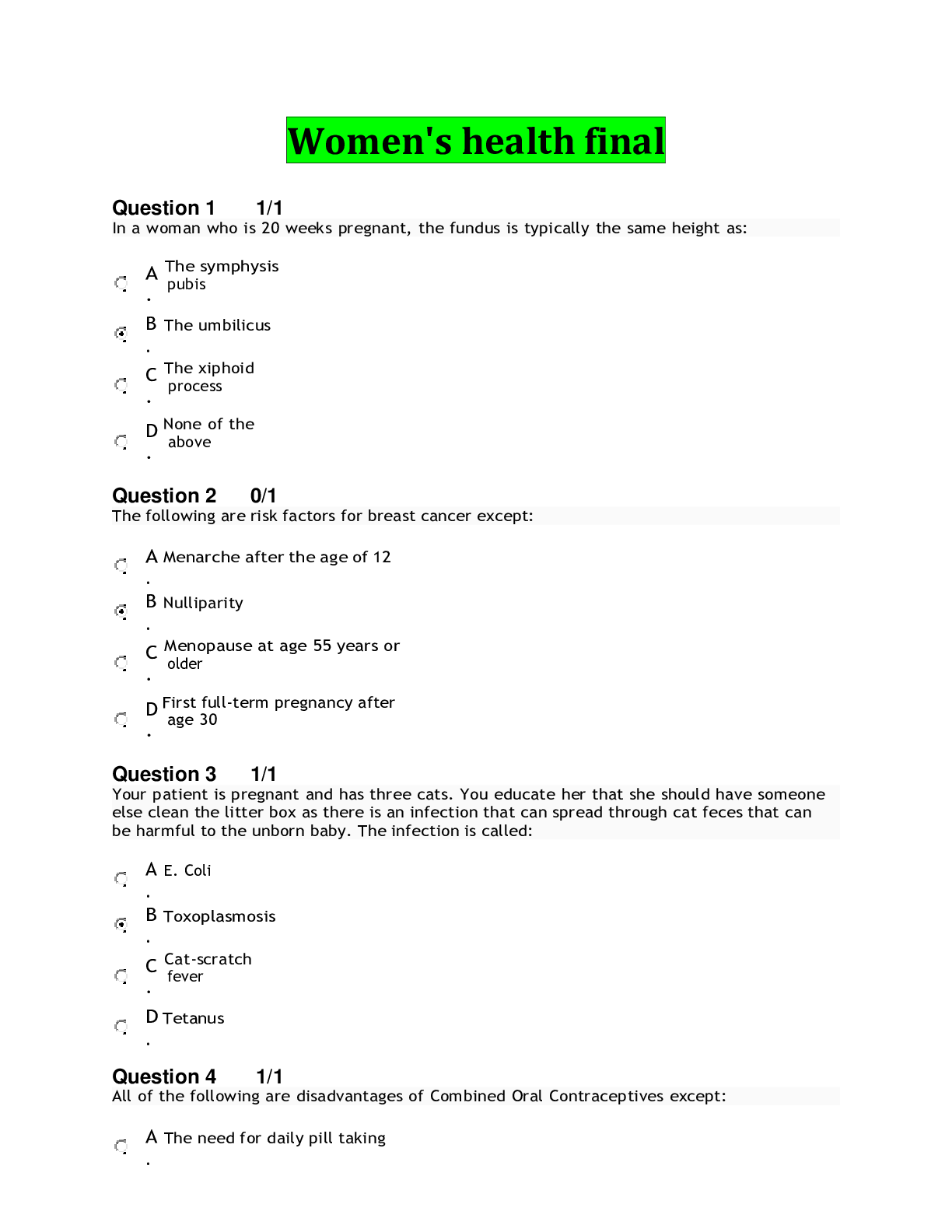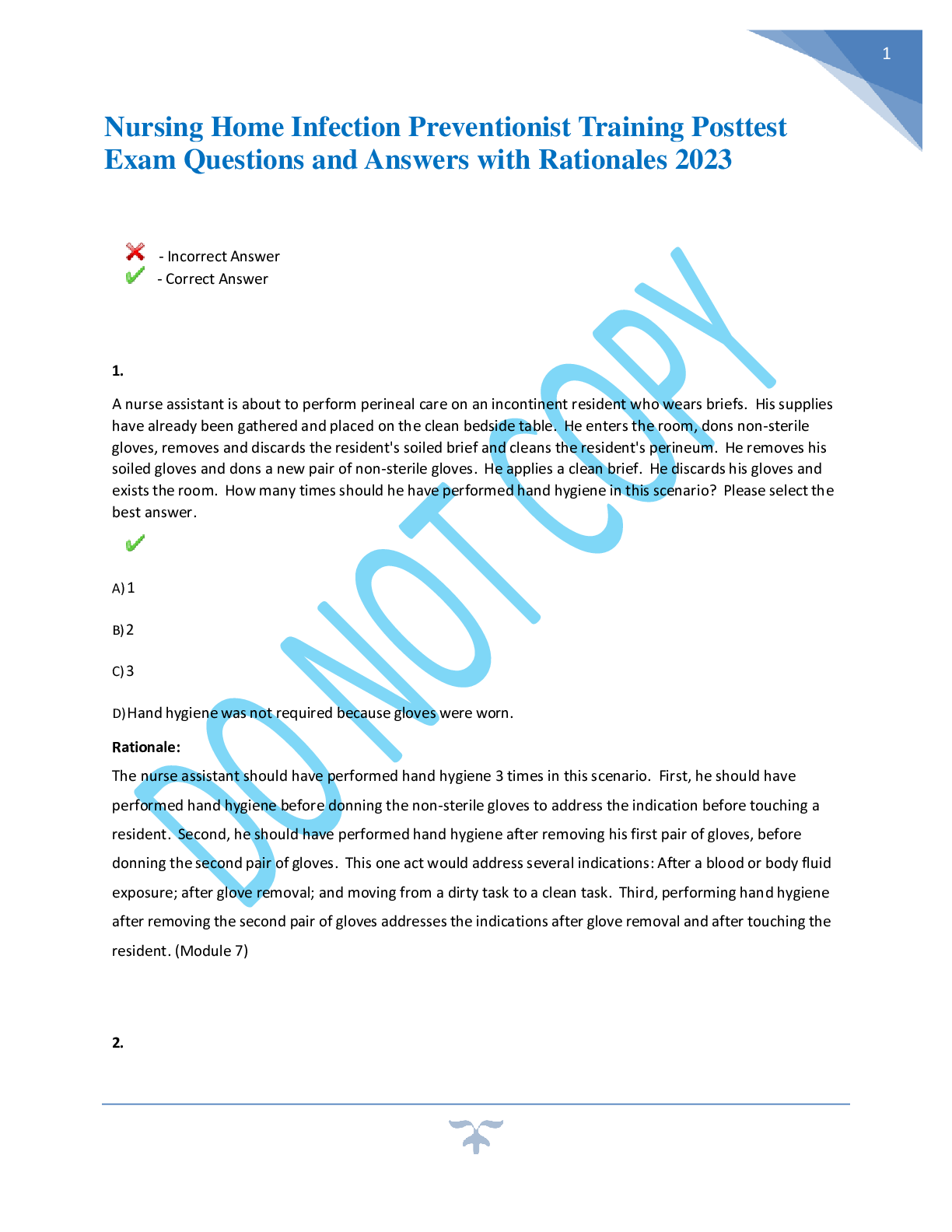Micro Biology > EXAM > BIO 171 Microbiology Module 6 Exam Questions and Answer elaborations | Download To Score An A (All)
BIO 171 Microbiology Module 6 Exam Questions and Answer elaborations | Download To Score An A
Document Content and Description Below
BIO 171 Microbiology Module 6 Exam M6: Module 6 Exam- Requires Respondus LockDown Browser Question 1 2 / 2 pts True or False. Although viruses may contain their genome within an enclosed spac... e (much like the nucleus of a cell), it is considered neither eukaryotic nor prokaryotic. Correct! True False Question 2 5 / 5 pts Describe the two basic components of a virus. Your Answer: Genomic material comprised of either DNA or RNA and a capsid A virus has (1) genomic material comprised of either DNA or RNA and (2) a capsid, a membrane-like protective structure that contains the genetic material, similar to the nucleus of a eukaryotic cell. Question 3 3 / 3 pts The surrounds the capsid of some viruses. Your Answer: envelope envelope Question 4 2 / 2 pts True or False. You would expect to see a viral envelope on a virus infecting a bacterial cell. True Correct! False False. The overwhelming majority of animal viruses are enveloped whereas the majority of plant or bacteria-infecting viruses are not. Question 5 3 / 3 pts Rank the following viruses based on their size from largest to smallest: Orthomyxovirus Poliovirus Variolavirus Your Answer: 1. Variolavirus 2. Orthomyxovirus 3. Polivirus Variolavirus (~200nm) > Orthomyxovirus (100-150nm) > Poliovirus (~30nm) Question 6 2 / 2 pts True or False: Viral replication occurs after it attaches and enters the host cell. Correct! True True. The viral genome is never replicated before attachment and entry. False Question 7 5 / 5 pts Place the following viral life cycle steps in order beginning with viral attachment and provide a description of each step. Uncoating: Release: Replication: Attachment: Entry: New infection: Your Answer: 1. Attachment: viral receptors bind to a host proteins on te surface of the cell. 2. Entry: The virus fuses with the host membrane and enters the cell 3. Uncoating: The viral capsid dissasembles 4. Replication: The viral genome provides the blueprint to make copies of itself 5. Exit: New viruses are produced and leave a cell. 6. New infection: Newly produced viruses leave the host cell and go on to infect new cells. The process outlined above now restarts. 3- Uncoating: the viral capsid disassembles 5-Release: New virus particles are produced and leave the cell 4-Replication: the viral genome is the ‘blueprint’ to make copies of itself 1- Attachment: viral receptors bind to host proteins on the surface of the cell 2- Entry: the virus fuses with the host membrane and enters the cell 6-New infection: newly produced viruses that left the host cell now go on to infect new cells. Question 8 3 / 3 pts A virus that infects bacteria is called a [answer1] and contains a [answer2] -sided polygon capsid. Your Answer: 1. bacteriophages 2. 20 sided polygon capsid 1. Bacteriophage 2. 20 Question 9 2 / 2 pts True or False. Structurally, bacteriophages are similar to viruses that infect animals. True Correct! False False. Bacteriophages have a distinct composition and structure. Question 10 5 / 5 pts Identify the following components of a bacteriophage. micro module 6 question.jpg 1-[answer1] 2- [answer2] 3- [answer3] 4- [answer4] 5- [answer5] Your Answer: 1. Capsid 2. Collar 3. Tail 4. Base Plate 5. Tail Fibers 1- Capsid 2- Collar 3- Tail 4- Base plate 5- Tail fibers Question 11 5 / 5 pts Describe the main differences between lytic and temperate phages. Your Answer: Lytic bacteriophages replicate within a host bacteria until it lyses, temperate if viral genome is intergrated into the host genome without actively replicating it is considered dormancy Lytic bacteriophages replicate within the host bacteria until it ruptures, whereas temporate (or lysogenic) phages primarily exist in a non-replicative state that does not kill the host cell. Lytic phages replicate all viral proteins needed for the assembly of new virus particles whereas lysogenic phage genomes are integrated into the host genome but production of viral proteins is suppressed. Question 12 2.5 / 5 pts Based on the following image, would you expect the viral titer to be high or low? Why? micro module 6 question 2.jpg Your Answer: low Low. As turbidity is a function of the number of intact bacterial cells present in the media, the amount of virus contained within the above tube must be low. As the lytic cycle continues more and more bacterial cells will be destroyed, effectively clearing the media. Question 13 2 / 2 pts Which of the following can be spread via airborne particles: Measles Mumps Rubella A and B Correct! All of the above Measles, mumps and rubella can all be spread via airborne particles formed while coughing, sneezing, etc. Question 14 2 / 2 pts True or False. A patient infected with rubella is only considered infectious when the trademark rash is visible. True Correct! False False. A patient infected with Rubella is infectious one week before and one week after the appearance of the rash. Question 15 2 / 2 pts A patient diagnosed with German measles may additionally experience what disease? Select all that apply. Impetigo Correct! Conjunctivitis Rheumatic fever Correct! Influenza-like symptoms A patient may experience a combination of symptoms such as fever, flu-like symptoms (influenza), cough, conjuctivitis, and a red blotchy skin rash. Question 16 2 / 2 pts Which of the following diseases does a linear, double-stranded DNA virus cause? Measles Mumps Rubella B and C Correct! None of the above Measles, mumps and rubella are all linear, single-stranded RNA viruses. Question 17 0 / 3 pts What disease displays as a secondary characteristic swelling of the testes/ovaries and pancreas? Your Answer: Mumps. A patient infected with mumps (aka epidemic paratitis) has primary swelling in the paratoid (salivary glands) located in the neck but also may have secondary swelling in the testes/ovaries and pancreas. Question 18 2.5 / 5 pts Describe two ways chickenpox can be spread. Your Answer: Both airborne and droplet Chickenpox is highly contagious and can be transmitted (1) through both air-borne droplets (sneezing/coughs) or via (2) direct contact with the blisters of an infected individual. Question 19 2 / 2 pts True or False. The development of shingles is most often seen in an older adult population (> 60 years old). Correct! True True. The most common age for VZV reactivation and shingle diagnosis tends to occur in people around 60 years of age. False Question 20 2 / 2 pts True or False. Similar to chickenpox, the blisters that appear with shingles can cover the entire body. True Correct! False False. Unlike chickenpox blisters, which can form anywhere, the blisters associated with shingles are localized and limited to small areas. Question 21 2 / 5 pts A person who has neither previously had chickenpox nor been administered the VZV vaccine is exposed to someone with an active VZV (shingles) outbreak and becomes infected. Explain why (or why not) the person will only develop shingles. Your Answer: B?ecause VZV lies dormant in inactive nerve cells it is localized The infected individual will not develop shingles, but will develop chickenpox. Unvaccinated and unexposed individuals must first develop chickenpox, as shingles is the reactivation of the dormant VZV virus from the chickenpox infection. Question 22 5 / 5 pts While traveling abroad, should you be worried about coming into contact with either the Variola major or Variola minor viruses? Your Answer: NO both viruses are varients of smallpox which was eradicated in 1977 No. Both viruses are variants of smallpox and were eradicated in 1977. You would not need to worry about coming into contact with the virus. Question 23 3 / 3 pts What small (~30nm) single-stranded, non-enveloped RNA virus causes temporary or permanent paralysis by infiltrating (infecting) motor neurons within the spinal cord, brain stem, or motor cortex? Your Answer: Polio Polio, also known as poliomyelitis. Question 24 3 / 3 pts Describe the main underlining differences between the Salk and Sabin polio vaccine. Your Answer: Salk developed polio vaccine injection, Sabin developed oral polio vaccine. The Salk vaccine contained an inactivated form of the virus and was injected while the Sabin vaccine contained a live attenuated (weakened) form of the virus and was administered orally. Question 25 3 / 3 pts Which subtype of Influenza is the most virulent? Your Answer: Influenza a Influenza A Question 26 0 / 5 pts A drug company is trying to develop a new drug that will inhibit viral entry of Influenza. Would the drug company target hemagglutinin proteins or neuraminidase proteins? Why? Your Answer: Hemagglutinin (HA) proteins would be targets as they are directly involved in viral attachment and entry into the host cell. Neuraminidase proteins are involved in the budding and release of new viral particles and would thus not be the correct target. Question 27 5 / 5 pts Explain why the flu shot given each year may not be 100% effective at preventing the flu? Your Answer: Medical researchers predict and then distribute flu vaccines based on most commom strains. This model is not ale=ways 100 percent accurate. for this reason it is possible to receive the flu vaccine and still get the flu in the same season. It is possible to receive a flu vaccine and yet (unfortunately) still get the flu in the same season if you are exposed to a viral strain that was not included in the vaccine. There are a large number of variants and the flu vaccine is unable to vaccinate against all subtypes. Medical researchers predict and then distribute flu vaccines based current trends and the available data relative to the most common circulating strains. Unfortunately, this model is not always 100% accurate. Question 28 2 / 2 pts True or False. The viral capsid of HIV is cone shaped and contains ~2,000 copies of the viral protein p24. Correct! True False Question 29 2 / 2 pts The HIV surface glycoprotein gp41 binds what host cellular receptor? CD4 Correct! CXCR4 HIV gp41 binds to the receptor CXCR4 CD3 CXCR5 Question 30 5 / 5 pts An individual infected with HIV is placed on anti-retroviral medication. Describe how the medication will affect the virus. Your Answer: It combats the virus ability to reproduce As the name suggests, anti-retrovirals are intended to inhibit (anti) the process of reverse-transcription (retro). Once the virus enters the cell and uncoating is complete, the viral enzyme reverse transcriptase (RT) acts on the two RNA copies, creating a complementary DNA strand. Anti-retrovirals attempt to block this step. In the absence of anti-retroviral medications, the now double-stranded DNA is transported to the nucleus where it can integrate into the host genome and begin replicating. By inhibiting the process of RT, anti-retroviral medications effectively block the production of new viruses by preventing its integration and replication. Quiz Score: 84 out of 100 Submission Details: [Show More]
Last updated: 1 year ago
Preview 1 out of 13 pages

Reviews( 0 )
Document information
Connected school, study & course
About the document
Uploaded On
Aug 11, 2022
Number of pages
13
Written in
Additional information
This document has been written for:
Uploaded
Aug 11, 2022
Downloads
0
Views
59
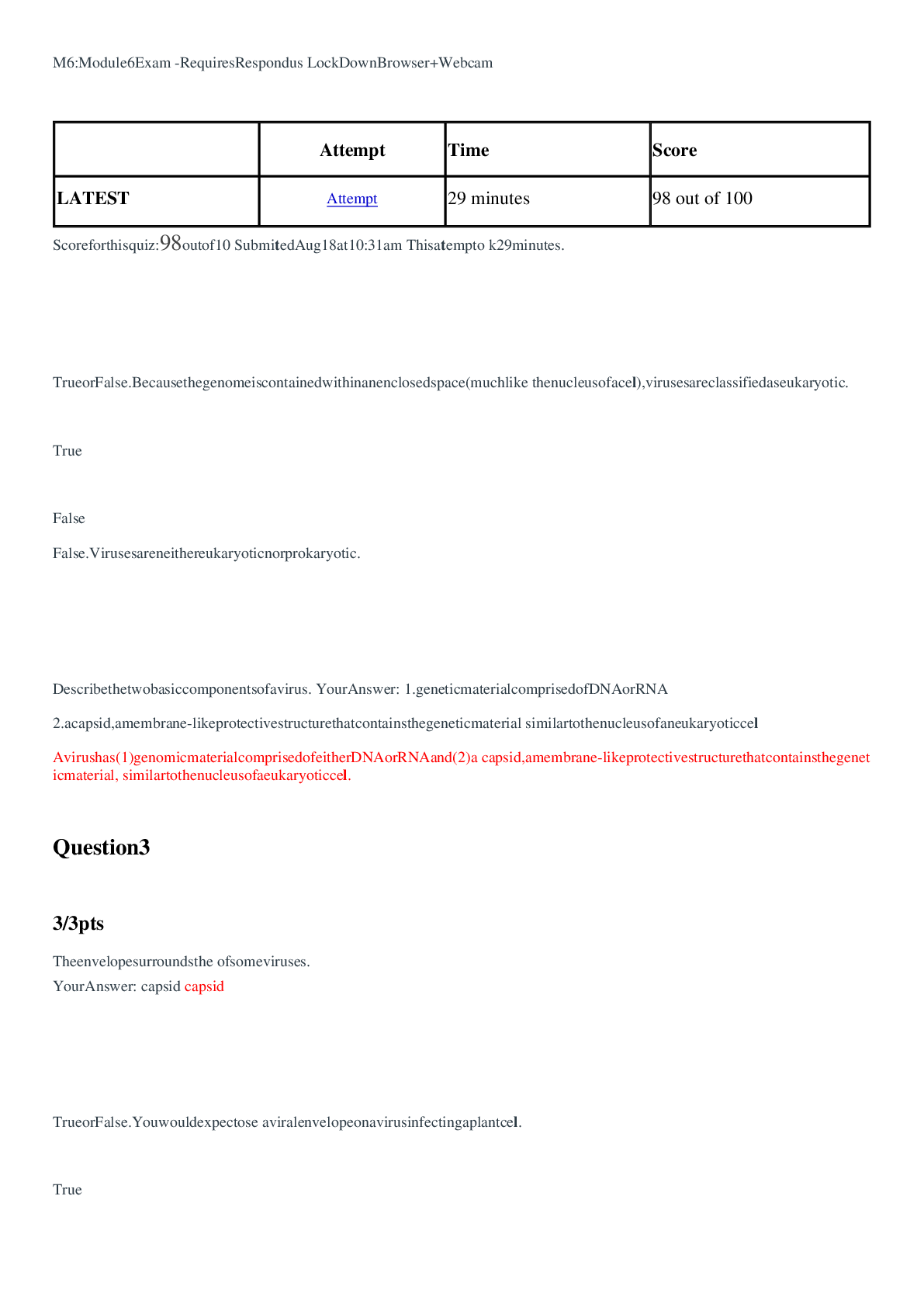



.png)










